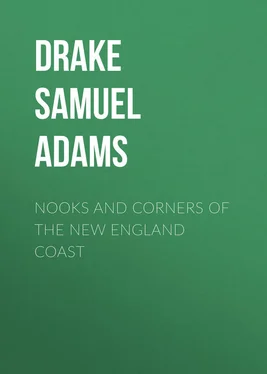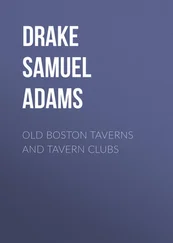Samuel Drake - Nooks and Corners of the New England Coast
Здесь есть возможность читать онлайн «Samuel Drake - Nooks and Corners of the New England Coast» — ознакомительный отрывок электронной книги совершенно бесплатно, а после прочтения отрывка купить полную версию. В некоторых случаях можно слушать аудио, скачать через торрент в формате fb2 и присутствует краткое содержание. Жанр: foreign_antique, foreign_prose, на английском языке. Описание произведения, (предисловие) а так же отзывы посетителей доступны на портале библиотеки ЛибКат.
- Название:Nooks and Corners of the New England Coast
- Автор:
- Жанр:
- Год:неизвестен
- ISBN:нет данных
- Рейтинг книги:3 / 5. Голосов: 1
-
Избранное:Добавить в избранное
- Отзывы:
-
Ваша оценка:
- 60
- 1
- 2
- 3
- 4
- 5
Nooks and Corners of the New England Coast: краткое содержание, описание и аннотация
Предлагаем к чтению аннотацию, описание, краткое содержание или предисловие (зависит от того, что написал сам автор книги «Nooks and Corners of the New England Coast»). Если вы не нашли необходимую информацию о книге — напишите в комментариях, мы постараемся отыскать её.
Nooks and Corners of the New England Coast — читать онлайн ознакомительный отрывок
Ниже представлен текст книги, разбитый по страницам. Система сохранения места последней прочитанной страницы, позволяет с удобством читать онлайн бесплатно книгу «Nooks and Corners of the New England Coast», без необходимости каждый раз заново искать на чём Вы остановились. Поставьте закладку, и сможете в любой момент перейти на страницу, на которой закончили чтение.
Интервал:
Закладка:
The shell heaps are of common occurrence all along the coast. The reader knows them for the feeding-places of the hordes preceding European civilization. Here they regaled themselves on a delicacy that disappeared when they vanished from the land. The Indians not only satisfied present hunger, but dried the oyster for winter consumption. Their summer camps were pitched in the neighborhood of well-known oyster deposits, the squaws being occupied in gathering shell-fish, while the men were engaged in fishing or in hunting.
Josselyn mentions the long-shelled oysters peculiar to these deposits. He notes them of nine inches in length from the "joint to the toe, that were to be cut in three pieces before they could be eaten." Wood professes to have seen them of a foot in length. I found many of the shells here of six inches in length. Winthrop alludes to the oyster banks of Mystic River, Massachusetts, that impeded its navigation. During recent dredgings here oyster-shells of six to eight inches in length were frequently brought to the surface. The problem of the oyster's disappearance is yet to be solved. 58 58 Williamson mentions the heaps on the eastern bank, not so high as on the western, extending back twenty rods from the river, and rendering the land useless. The shell heaps of Georgia and Florida are more extensive than any in New England.
CHAPTER VII.
MONHEGAN ISLAND
"From gray sea-fog, from icy drift,
From peril and from pain,
The home-bound fisher greets thy lights,
Oh hundred-harbored Maine!"
The most famous island you can find on the New England map is Monhegan Island. To it the voyages of Weymouth, of Popham, and of Smith converge. The latter has put it down as one of the landmarks of our coast. Rosier calls it an excellent landfall. It is undoubtedly Monhegan that is seen on the oldest charts of New England. Champlain, with the same aptness and originality recognized in Mount Desert and Isle au Haut, names it La Tortue. Take from the shelf Bradford, Winthrop, Prince, or Hubbard, and you will find this island to figure conspicuously in their pages. Bradford says starving Plymouth was succored from Monhegan as early as 1622. The Boston colonists of 1630 were boarded when entering Salem by a Plymouth man, going about his business at Pemaquid. English fishing ships hovered about the island for a dozen years before the Mayflower swung to her anchorage in the "ice-rimmed" bay. The embers of some camp-fire were always smouldering there.
Sailing once from Boston on a Penobscot steamboat, a few hours brought us up with Cape Ann. I asked the pilot for what land he now steered.
"M'nhiggin."
In returning, the boat came down through the Mussel Ridge Channel like a race-horse over a well-beaten course. We rounded Monhegan again, and then steered by the compass. Monhegan is still a landmark.
A wintry passage is not always to be commended, especially when the Atlantic gets unruly. Leaving the wharf on one well-remembered occasion, we steamed down the bay in smooth water at fourteen miles an hour. All on board were in possession of their customary equipoise. Soon the gong sounded a noisy summons to supper. We descended. The cabin tables were quickly occupied by a merry company of both sexes. There was a clatter of plates and sharp clicking of knives and forks; waiters ran hither and thither; the buzz of conversation and ripple of suppressed laughter began to diffuse themselves with the good cheer, when, suddenly, the boat, mounting a sea, fell off into the trough with a measured movement that thrilled every victim of old Neptune to the marrow.
It would be difficult to conceive a more instantaneous metamorphosis than that which now took place. Maidens who had been chatting or wickedly flirting, laid down their knives and forks and turned pale as their napkins. Youths that were all smiles and attention to some adorable companion suddenly behaved as if oblivious of her presence. Another plunge of the boat! My vis-à-vis , an old gourmand, had intrenched himself behind a rampart of delicacies. He stops short in the act of carving a fowl, and reels to the cabin stairs. Soon he has many followers. Wives are separated from husbands, the lover deserts his mistress. A heavier sea lifts the bow, and goes rolling with gathered volume astern, accompanied by the crash of crockery and trembling of the chandeliers. That did the business. The commercial traveler who told me he was never sea-sick laid down the morsel he was in the act of conveying to his mouth. He tried to look unconcerned as he staggered from the table, but it was a wretched failure. Two waiters, each bearing a well-laden tray, were sent sliding down the incline to the leeward side of the cabin, where, coming in crashing collision, they finally deposited their burdens in a berth in which some unfortunate was already reposing. All except a handful of well-seasoned voyagers sought the upper cabins, where they remained pale as statues, and as silent. The rows of deserted seats, unused plates, the joints sent away untouched, presented a melancholy evidence of the triumph of matter over mind.
Early in the morning we made out Monhegan, as I have no doubt it was descried from the mast-head of the Archangel , Weymouth's ship, two hundred and seventy years ago. The sea was shrouded in vapor, so that we saw the island long before the main-land was visible. Sea-faring people call it high land for this part of the world.
Near the westward shore of the southern half of this remarkable island is a little islet, called Mananas, which forms the only harbor it can boast. Captain Smith says, "Between Monahiggon and Monanis is a small harbour, where we rid." The entrance is considered practicable only from the south, though the captain of a coasting vessel pointed out where he had run his vessel through the ragged reefs that shelter the northern end, and saved it. It was a desperate strait, he said, and the by-standers shook their heads, in thinking on the peril of the attempt. 59 59 Monhegan lies nine miles south of the George's group, twelve south-east from Pemaquid, and nine west of Metinic. It contains upward of one thousand acres of land. According to Williamson, it had, in 1832, about one hundred inhabitants, twelve or fourteen dwellings, and a school-house. The able-bodied men were engaged in the Bank fishery; the elders and boys in tending the flocks and tilling the soil. At that time there was not an officer of any kind upon the island; not even a justice of the peace. The people governed themselves according to local usage, and were strangers to taxation. A light-house was built on the island in 1824.
The inhabitants are hospitable, and many even well to do. Their harbor is providentially situated for vessels that are forced on the coast in heavy gales, and are able to reach its shelter. At such times exhausted mariners are sure of a kind reception, every house opening its doors to relieve their distresses. Having all the requirements of snug harboring, excellent rock fishing, with room enough for extended rambling up and down, the island must one day become a resort as famous as the Isles of Shoals. At present there is a peculiar flavor of originality and freshness about the people, who are as yet free from the money-getting aptitudes of the recognized watering-place.
George Weymouth made his anchorage under Monhegan on the 18th of May, 1605. "It appeared," says Rosier, "a mean high land, as we afterward found it, being an island of some six miles in compass, but, I hope, the most fortunate ever yet discovered. About twelve o'clock that day, we came to an anchor on the north side of this island, about a league from the shore. About two o'clock our captain with twelve men rowed in his ship-boat to the shore, where we made no long stay, but laded our boat with dry wood of old trees upon the shore side, and returned to our ship, where we rode that night." * * *
Читать дальшеИнтервал:
Закладка:
Похожие книги на «Nooks and Corners of the New England Coast»
Представляем Вашему вниманию похожие книги на «Nooks and Corners of the New England Coast» списком для выбора. Мы отобрали схожую по названию и смыслу литературу в надежде предоставить читателям больше вариантов отыскать новые, интересные, ещё непрочитанные произведения.
Обсуждение, отзывы о книге «Nooks and Corners of the New England Coast» и просто собственные мнения читателей. Оставьте ваши комментарии, напишите, что Вы думаете о произведении, его смысле или главных героях. Укажите что конкретно понравилось, а что нет, и почему Вы так считаете.












